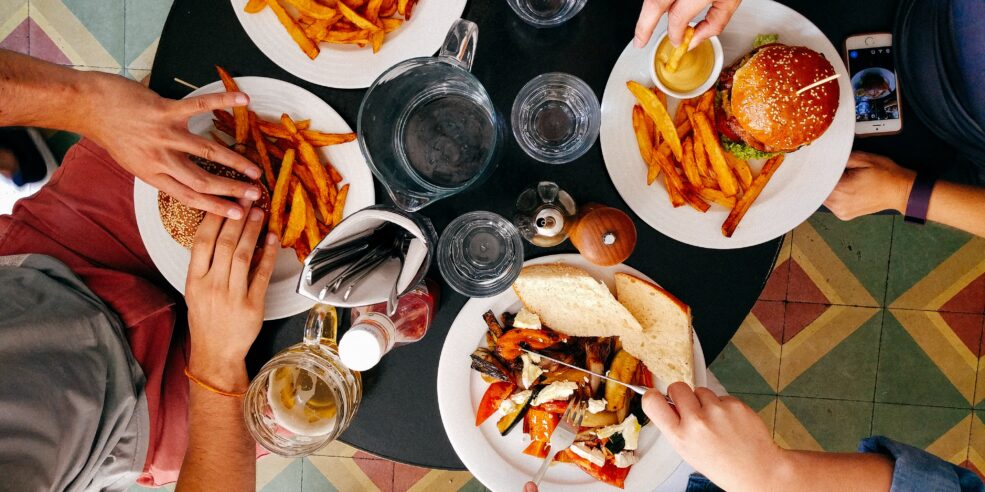In this article
The prospect of reopening for eat-in customers is finally on the horizon for hospitality businesses in the UK. With a July 4th opening date to look forward to, many businesses have been questioning whether opening with social distancing measures in place and capped capacities will be profitable, as well as trying to figure out the best way to do it.
There is good news though – it looks as if the public are very keen to return to restaurants and eating out. In countries that have already reopened such as Hong Kong and France, the demand is definitely there – cafes in Paris saw the return in droves of their customers who had gone months without their daily espresso and restaurants in Hong Kong who have implemented new safety measures such as perspex screens still saw customers coming through the door. And in the UK, who would have predicted the hours-long queues when drive-throughs reopened? People are clearly fed up with cooking at home – they want to return to their favourite places.
In this article, we look at how restaurants can feasibly reopen to eat-in diners as well as the operational changes that will have to be implemented to ensure safety for everyone.
The path to reopening
First of all, it’s important to consider which locations should open first. A key factor here will be whether the UK government decides to reduce social distancing to 1 metre from the 2 metres it currently is. Economically, keeping the distance at 2m could have devastating effects with over 3 million jobs at risk. However, considering that WHO has said that 1 metre mitigates most of the risk of infection, we have to hope that the government will soon change the rules.
Whatever the government decides to do, locations with the most square footage will be the best reopening options to begin with as they are most likely to be able to cater for social distancing as well as potential 50% capacity caps without operating at a complete loss. Cramped locations with majority counter seating may have to think more creatively to be able to fit customers in, or may have to consider different options. The owners of Flor in Borough Market realised that with social distancing in place they would only be able to fit a 6 customers inside, so decided to launch ASAP Pizza out of its kitchen, providing gourmet click and collect and delivery pizza for their clients.
As summer approaches, any location with outdoor seating will be in high demand. Not only will it mean extra space to fit customers, but diners will likely feel much safer outside in the fresh air than inside surrounded by people. And on the topic of feeling comfortable and safe, it is worth thinking about the core demographic of each of your locations. Younger people, who were most likely not to comply with lockdown protocol anyway, are more likely to brave going out at the beginning whereas older generations may feel slightly more tentative about resuming life as we knew it.
In terms of geographical location, consider how people will get to you. Places where walking and driving are more popular than public transport should have priority in your reopening schedule. This might mean eschewing London to begin with and instead focusing on the suburbs and other large cities. But do think about delivery and takeaway potential – locations in London near large parks where people can take their food and enjoy it picnic-style with friends might find themselves most successful.
Contactless experience
Once you’ve decided which locations to reopen, the next step will be all the small operational changes that a more socially distant world requires. Things that we never thought about in the past will now be at the front of everyone’s mind.
Take menus, for example. I think it’s fair to say that communal menus are now a thing of the past. Switching to single use menus, like placemats, is one option – though incredibly wasteful, as well as having one general menu on the wall for people to consult. But there are also a bunch of innovative technology solutions for table-side or contactless ordering. Apps like Ordamo, Presto, Wi-Q, and Wi-5 all allow customers to order straight from their mobile phones after scanning a QR code or going to a specific URL – make sure they integrate with your POS though, as manually inputting orders is timely and incredibly inefficient.
Using apps for contactless ordering also allows for contactless payment. The less interaction your staff have to have with customers, potentially the better. Thinking of your staff’s safety may also mean going cashless as well as considering contactless card payment limits when thinking about pricing. If your average spend is £47, considering lowering the price of items to get under the £45 threshold. Also consider multiples, i.e if you usually serve 2 guests whose average is £25, consider reducing to £22 so one person can pay with contactless.
Rethink your basics
When reopening your restaurant, don’t just go back to what you were doing pre-Covid. Make sure you’re making conscious decisions about every element. You might think about cutting down your core menu, for example, as seen at Nando’s. Giving fewer options makes it easier on your staff, especially if you’re working with a reduced crew because of social distancing. Streamlining your menu also allows you to reduce waste when you first reopen and as you judge demand.
You should also consider the hours you’re open. Don’t conform to what you were doing previously. Dishoom and Hawksmoor have both been considering the need to open for breakfast if the majority of their clientele are still working from home. Also remember that while weeknights may have been popular, now that most people don’t have to leave their homes during the day, they are less likely to want to venture out at night. However, weekends might be even busier than before with people finally wanting to get out of their own environments after 5 days of staring at the same 4 walls.
Reservations will also be your friend at the beginning. You’re going to want to be full all the time if you can only operate at 50% capacity and accepting reservations is a sure-fire way to figure out how you can best do that. To avoid no-shows, take card numbers as collateral, and charge a fee if people don’t show. Reservations will also stop any milling and waiting that could compromise social distancing. Using reservation platforms like SevenRooms, OpenTable or ResDiary that will also integrate with your POS will make this process very simple.
And remember, while 50% capacity may seem daunting, you might find that you’re able to turn tables more quickly as people avoid dwelling in one place for too long, and you will still have takeaway orders making up for the decrease in eat-in customers. A key to being successful here will be to figure out exactly how much you are going to make from dine-in (assume 50%), so you know how much takeaway or delivery business you need in order to break even. It might also be worth considering operating at a slight loss to increase brand awareness in the long term.
You might even want to set up an outdoor concession stand selling ice cream, sandwiches, pastries, coffee or even cocktails to make the most of passers-by. Footfall is likely to go up from the 15th of June when non-essential retail stores can reopen and people will still be keen for food on the go. (The Ritz in Paris has started doing this with very happy results.)
The key to all of this will be very close tracking of everything from your guest counts, to the time it takes to turn tables, and how well each channel is performing. Being able to make quick decisions based on real data will be in your best interest, so you can know when something is working and when it’s not, when to push or when to pull back.
Safety
The safety of your staff and your customers should be priority number one. It is likely that the government will make wearing masks a legal requirement for restaurant employees, but you should still use them if it isn’t. Masks make people feel more comfortable. Your employees should be using disposable masks as these can be changed often and provide more droplet filtration. However, you might be able to personalise these with your restaurant’s colours and logo to make them less hospital-like.
You should also be focused on keeping all of your surfaces as clean as possible. Consider setting up alerts for staff to remind them to wipe down high-contact areas such as door handles and chairs on an extremely regular basis. You can make use of your labour scheduler here – some allow you to set tasks for staff to do throughout their shifts which must be ticked off. Otherwise, apps like Trail or even shared Apple reminders would help you keep track of cleaning schedules.
You might even want to go further safety-wise like some restaurants in Hong Kong have done, with temperature checks at the door, denying entry to anyone with a raised temperature. Or you could even deliver personalised hand sanitiser bottles to every customer upon arrival. The main thing here is to make your customers as comfortable as possible while still providing them with great service.
Most importantly, make sure to share what you are doing with your customers! People are going to want to support local businesses and their favourite eateries, so making sure your regulars know you’re open and that you are seriously considering all of the safety elements is great PR at the moment. Remember to use all of your resources, including social media and past newsletter lists to make sure the message circulates as widely as possible. Maybe even consider making a video, such as the one Nando’s released, to explain all the changes you’ve made in an easily digestible format.
Conclusion
Reopening may be a slightly terrifying prospect at the moment, but as more guidance comes in from the government and restaurants can make concrete plans, the better it will be. At the end of the day, this is a very exciting moment, it’s almost like a fresh start. Customers are keen to get back to restaurants and while the experience might be a bit different to begin with, it can all be taken in stride.
If you would like to discuss your reopening plans, we’re always happy to chat. Email us at [email protected].




